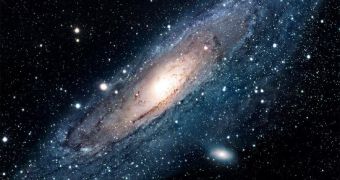A new paper in the Astrophysical Journal Letters details the discovery of a very crammed galaxy that sits in the Virgo cluster of galaxies, at a distance of about 54 million light years from the Milky Way. The galaxy has been named M60-UCD1.
Researchers have managed to pin down this galaxy with the help of NASA's Hubble Space Telescope. Later on, they relied on NASA's Chandra X-ray Observatory and ground-based optical telescopes to examine it further.
“Twenty years ago we couldn't have done this. We didn't have Hubble or Chandra. This is one of those projects where you bring together the full force of NASA's great observatories, plus ground-based resources,” believes Jay Strader, an assistant professor of physics and astronomy at the Michigan State University.
Scientists say that, as far as they can tell, half of this galaxy's mass can be found within a radius of about 80 light years. This means that, when compared to the Milky Way, the density of stars in the newly discovered galaxy is about 15,000 times greater.
As EurekaAlert explains, the galaxy is so dense that some 10,000 stars similar to our sun are crammed in a space of about 4 light years, which happens to be the distance between our sun and Alpha Centauri, i.e. the star closest to it.
“This galaxy is more massive than any ultra-compact dwarfs of comparable size, and is arguably the densest galaxy known in the local universe,” says Jay Strader.
“Traveling from one star to another would be a lot easier in M60-UCD1 than it is in our galaxy. Since the stars are so much closer in this galaxy, it would take just a fraction of the time,” the researcher goes on to explain.
The scientists who have had the chance to examine this newly discovered galaxy say that it has a bright X-ray source in its center. It is likely that this X-ray source is a giant black hole. If this is indeed the case, its mass would be about 10 million times bigger than that of our sun.

 14 DAY TRIAL //
14 DAY TRIAL //